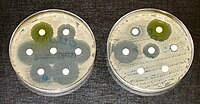
Photo from wikipedia
When exposed to antibiotics, some elusive bacteria lie low—so low, in fact, that they’re actually inaccessible to the drugs. Researchers first identified these unique antibiotic-tolerant cells, also known as persisters,… Click to show full abstract
When exposed to antibiotics, some elusive bacteria lie low—so low, in fact, that they’re actually inaccessible to the drugs. Researchers first identified these unique antibiotic-tolerant cells, also known as persisters, shortly after penicillin was first used to treat patients. As a clinician, Eleftherios Mylonakis saw first-hand the problems of bacterial persistence: Patients who were treated for infections, particularly those caused by Staphylococcus aureus—a common source of potentially dangerous bacterial infections—frequently experienced relapses after they had completed a course of antibiotics. Making matters worse, drug tolerance increases antibiotic use, which is both bad for patients and the ongoing drug resistance crisis. “It’s a real clinical problem for us,” says Mylonakis, who also studies infectious diseases at Brown University in Providence, RI. But decades after their discovery, researchers remain divided about the origins of persister cells and the nature of their evasive strategies. Nearly all bacteria can undergo physical changes to grow tolerant to antibiotics. Unlike the case of antibiotic resistance, however, some changes are not encoded in any unique genes; tolerance is not a heritable trait that can be transmitted between bacteria or over generations. Instead, changes associated with tolerance are ephemeral, and they are initiated by any number of genetic pathways. These changes can typically be reversed by tweaking the microbes’ environment. Some consider S. aureus—as seen in this scanning electron microscopic image in which human white blood cells (blue) are phagocytizing the bacteria (magenta spheres)—is a common source of potentially dangerous bacterial infections. Persister cells may contribute to infection relapses. Image credit: National Institute of Allergy and Infectious Diseases (NIAID).
Journal Title: Proceedings of the National Academy of Sciences of the United States of America
Year Published: 2022
Link to full text (if available)
Share on Social Media: Sign Up to like & get
recommendations!